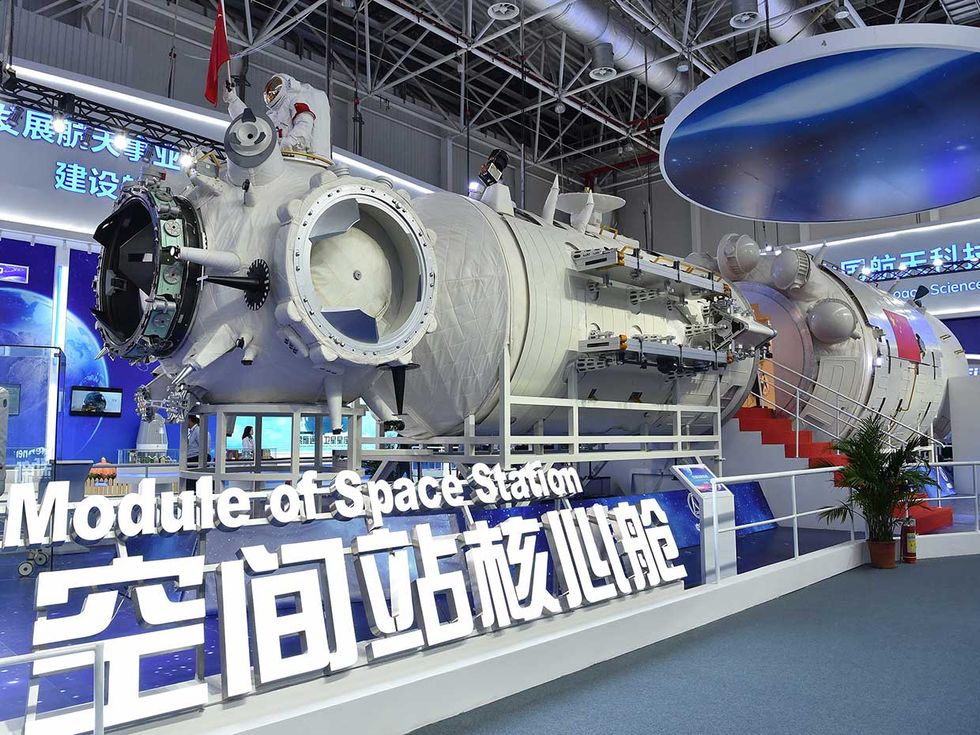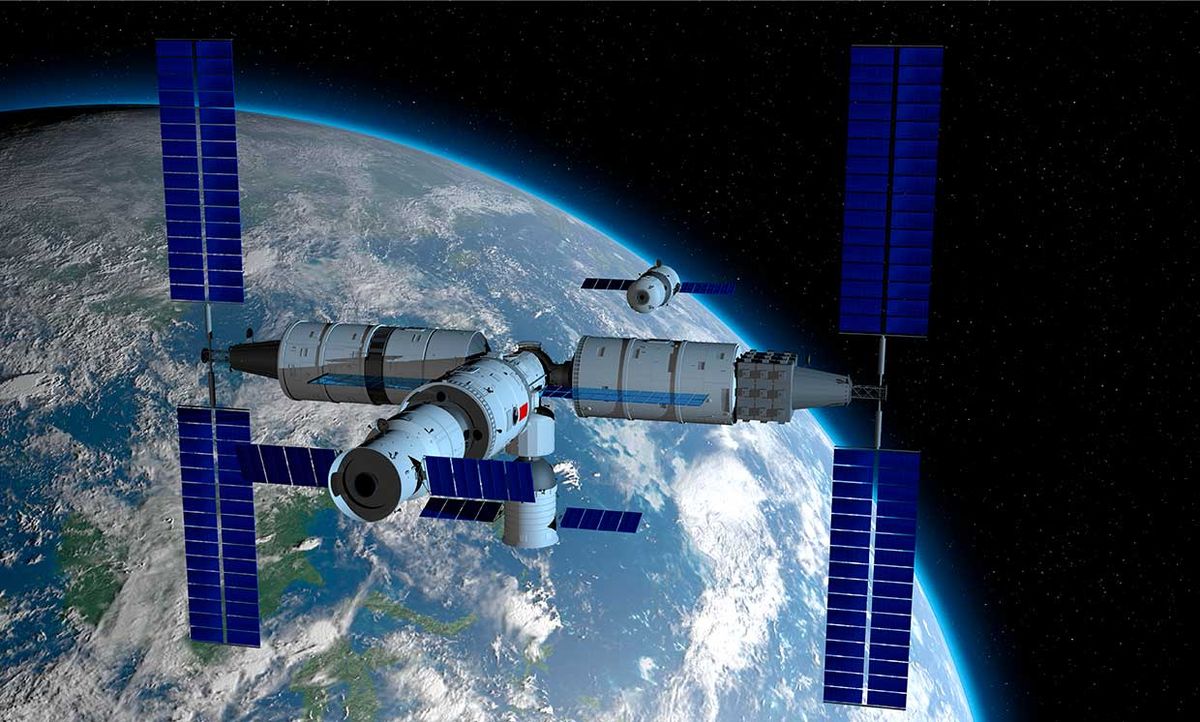Encased inside a payload fairing atop a huge Long March 5B rocket at Wenchang spaceport sits Tianhe, the first module for China’s space station project.
The Tianhe space station module launch, unofficially expected around 11 p.m. EDT on April 28 (Thursday), will end nearly three decades of preparation and kick off an intense period of 11 major missions. By the end of 2022 China aims to have constructed its three-module Chinese Space Station (CSS), a first project approved way back in 1992.
After being effectively blocked from joining the International Space Station by United States policy, China has moved ahead with its own, much smaller facility. While the ISS is around 420 metric tons, the T-shaped CSS will be around 66 tons, making it more comparable to Russia’s Mir.
It will however still be able to support three astronauts for up to six months at a time, and as many as six crew during mission changeovers, as well as a range of cutting edge science experiments.
Tianhe core module

The roughly 22-ton Tianhe, meaning “Harmony of the Heavens”, will be the core component of the station. (The station’s name is not to be confused with China’s equally ambitious Tianhe supercomputers, among the fastest in the world.)
The 16.6-meter-long, 4.2-meter-diameter module will provide life support and living quarters for astronauts. Tianhe also carries an attached docking hub which will facilitate the space station’s assembly. Two similarly-sized experiment modules, named Wentian and Mengtian, will connect with Tianhe in 2021.
The latter pair are designed mainly for scientific research, containing a total of 14 experiment racks for research into areas including biology in microgravity, fluid physics, materials science, combustion and space environment monitoring. A first selection of 17 international experiments will also travel to the CSS through a joint initiative between the China Manned Space Agency (CMSA) and the United Nations Office for Outer Space Affairs (UNOOSA).
Tianhe’s docking ports allow crewed Shenzhou and Tianzhou spacecraft to rendezvous and dock with the station. Four cargo spacecraft and four crewed missions will visit during the construction phase.
The module also carries robotic arms to aid construction and an airlock for facilitating extravehicular activities. China’s astronauts have been training underwater in preparation for upcoming spacewalks.
The CSS is expected to orbit at between 340-450 kilometers above the Earth for at least 10 years. Engines aboard Tianhe will regularly fire to raise its orbit, which otherwise gradually decays due to atmospheric drag. Its propulsion comes from both large thrusters—which will be refueled by propellant transfer from the Tianzhou spacecraft—as well as smaller ion thrusters. Two flexible solar arrays, each with a wingspan of 30 meters, will provide 27 kW of power to the orbital outpost.
After completion in 2022, astronauts, including a new batch featuring engineers and payload specialists, will begin long-term science missions. Around 2024 a Hubble-class space telescope will enter into a similar orbital plane and be able to dock with the CSS for maintenance, repairs and even upgrades. The Xuntian (“survey the heavens”) telescope will have a field of view 300 times greater than Hubble, allowing it to cover 40 percent of the sky over the course of a decade.
CSS origins, debris danger?
China committed to developing human spaceflight launch capabilities and a Shenzhou spacecraft capable of making it safely back through the atmosphere back in 1992. Longer term tests included developing life support, tracking, telemetry and control, data relay satellites and techniques such as orbital rendezvous and docking needed to get astronauts into space and allow them to work for long periods.
China became only the third and most recent country to develop independent human spaceflight launch capabilities in October 2003 with the launch of Yang Liwei about Shenzhou 5.
China over its next five crewed flights expanded to two and three astronaut crews, tested life support aboard two small Tiangong testbed space labs in 2012 and 2016 and finally tested refueling in microgravity with the Tianzhou-1 cargo spacecraft in 2017.
The Long March 5B was developed specifically to launch space station modules. It required breakthroughs in manufacturing strong yet thin five-meter-diameter rocket cores and new, cryogenic high-thrust rocket engines.
The test launch in May last year saw the core stage achieve orbital velocity to deliver a prototype crew spacecraft into orbit. Normally such large stages do not enter orbit, and the countries responsible for the missions plan for the debris to fall into a preplanned area of the ocean or, in the case of SpaceX, often vertically land the core stage.
Once the Long March 5B core stage goes orbital it may stay up for around a week, but there is no telling exactly where or when the stage will reenter the atmosphere. While much of it will burn up, some debris will fall to Earth anywhere between around 43 degrees north and south, the intended orbital inclination of Tianhe. The test mission core stage passed over New York 15 minutes before crashing to Earth.
If something major goes wrong with launch it appears there is a backup module waiting. If all goes well, the backup modules could be used to expand the CSS to six modules. China took this approach with its robotic lunar program, repurposing a backup rover for a pioneering lunar far side mission after an earlier successful moon landing.
China is also planning to have a Shenzhou spacecraft and Long March 2F rocket on standby at all times at Jiuquan Satellite Launch Center in the Gobi Desert to launch as soon as possible in the case of emergencies.
The space station will provide China with a wealth of human spaceflight experience over the next decade. At the same time the country is engaging in robotic lunar exploration. The two projects seem likely to converge to allow China to send astronauts to the moon in the 2030s.
Before all of those possibilities, the crucial launch of Tianhe may be streamed live by CCTV (Chinese) or CGTN in English on Youtube.
Andrew Jones is a freelance journalist based near Helsinki. He writes about the space industry and technology with a particular focus on China's activities.



